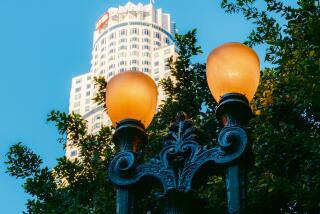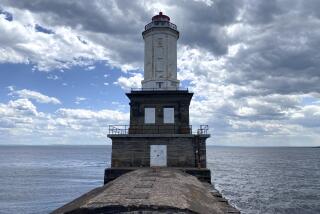A Keeper of the Flame Shines On
- Share via
CONEY ISLAND LIGHTHOUSE, N.Y. — Frank Schubert, 74, is the last civilian lighthouse keeper in America.
“I’m a relic,” laughed Schubert, a tall, husky man who rapidly climbed the 78 steps of the circular iron stairway leading to the top of the narrow 75-foot-high Coney Island Light.
The century-old lighthouse overlooks the entrance to New York bay at the southern tip of Brooklyn. It is located just down the street from the parachute jump at the famous amusement park and not far from Nathan’s Coney Island hot dog stand.
As he climbed the steep stairway with obvious ease Schubert explained why he called himself a relic. “I hired on with the U.S. Lighthouse Service in 1937. At first, I was a quartermaster on the Tulip, a ship that maintains markers and sea lanes.”
Two years later, when the Coast Guard took over the Lighthouse Service, Schubert stayed on as a civilian employee and became a lighthouse keeper. He has been operating the Coney Island Light since 1960.
But this era is coming to an end. Within a year all of the six remaining manned lighthouses in the United States will be automated. They are Coney Island and five others cared for by Coast Guard personnel: Boston Light; Egmont Key, Fla.; Block Island, R.I.; Goat Island, and Kennebeck, Me.
All the other lighthouses in the United States along the Atlantic and Pacific seaboards, the Gulf Coast and Great Lakes have been automated over the past few years.
Boston Light, originally constructed in 1716 as the nation’s first lighthouse, is scheduled to be the last one automated. That is, unless legislation introduced by Sen. Edward M. Kennedy (D-Mass.) to prevent automation and keep the Boston Light manned is passed.
Civilians operated lighthouses for the U.S. Lighthouse Service until 50 years ago when the U.S. Coast Guard was assigned the task. Gradually, over the years, the Coast Guard phased out all remaining civilians until finally only Frank Schubert was left.
Schubert is the last of thousands of civilian lighthouse keepers who guided ships at sea into safe harbors for 273 years. Since Boston Light was erected in 1716, America has built more than 1,500 lighthouses, but there were never more than 850 operating at any given time, according to Wayne Wheeler, president of the San Francisco-based U.S. Lighthouse Society.
George Worthylake was America’s first lighthouse keeper. In 1718, two years after he went to work at the Boston Light, he and his family drowned when his boat overturned in stormy seas. Benjamin Franklin wrote a poem about Worthylake’s tragic end.
Although Coney Island Light will be fully automated before the end of the year, Schubert will continue to live in the century-old, two-story brick-keeper’s house next to the light tower.
“The Coast Guard wants me to stay on and I surely don’t want to leave,” said Schubert. “I will remain here as caretaker because of the threat of vandalism.”
If the lighthouse were unattended, he added, “there wouldn’t be much left of the place after a few days. The Coast Guard could put up steel doors and steel blinds on the windows, but it would not make any difference. Thieves would come in and strip the place of everything of any value.”
“I was painting the outside of the house recently and came in to get a cup of coffee. When I returned, the ladder and can of paint were gone. Nothing is safe or sacred around here,” he gloomily noted.
Schubert, who was born on Staten Island across from the lighthouse, raised his three children at the Coney Island Light. His wife of 43 years, Marie, died three years ago. “She loved it here as much as I do. The Coast Guard says I can stay as long as I want. My plan is to stay as long as I live.”
He hasn’t had a vacation since 1958--by choice. The only time he leaves, he said, is for a death in the family. He does all the plumbing, electricity, carpentry, painting and gardening on the two structures.
He is responsible for maintaining the lighthouse and the light, which is visible for 14 miles and flashes 3/10ths of a second every five seconds.
“The most excitement I can remember around here was about 10 years ago when a tanker and a freighter collided in the bay. They drifted by the lighthouse looking like a tremendous torch from the explosion. More than 19 men lost their lives aboard the two ships,” recalled Schubert.
Coney Island Lighthouse is still vital to scores of ships that come in and out of New York harbor every day. “Years ago most of the skippers on the ships would give me a three-whistle greeting,” mused the lighthouse keeper.
“That was in the good ol’ days when all the lighthouses were manned. Captains on ships today probably think no one lives here any more, so why bother blasting the whistle. It’s too bad. Times change.”
More to Read
Sign up for Essential California
The most important California stories and recommendations in your inbox every morning.
You may occasionally receive promotional content from the Los Angeles Times.













